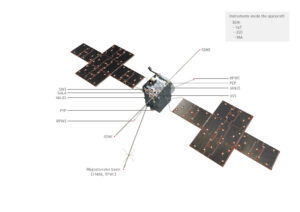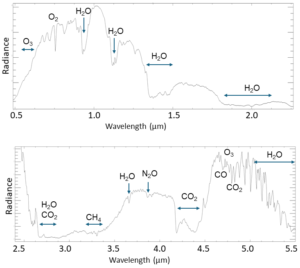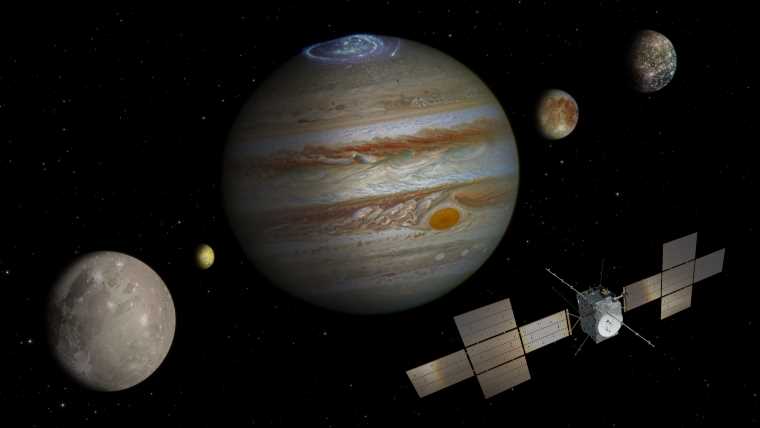An interplanetary spacecraft designed to scan Jupiter’s moons for signs of life has confirmed the efficacy of its instruments by confirming something we already know: that Earth is habitable. Built and launched by the European Space Agency (ESA), the Jupiter Icy Moons Explorer (Juice) mission successfully detected several chemical biosignatures in Earth’s atmosphere as well as temperature and topological data from its surface that support the idea that Earth is capable of sustaining life as we know it.
According to the team behind the confirmation, this expected finding shows that two of the eleven instruments aboard Juice that are designed to scan Jupiter’s moons for signs of life, the Moons and Jupiter Imaging Spectrometer (MAJIS) and the Submillimetre Wave Instrument (SWI), are working correctly, as Earth is inhabited.
“We are obviously not surprised by these results… it would have been extremely concerning to find out that Earth was not habitable!” quipped ESA Juice project scientist Olivier Witasse in a statement. “But they indicate that MAJIS and SWI will work very successfully at Jupiter, where they will help us investigate whether the icy moons could be potential habitats for past or present life.”


JUICE Will Scan Jupiter’s Moons for Biosignatures
Since the dawn of the space age, scientists have been looking for ways to determine if humanity is alone in the cosmos. Projects like SETI have spent over 60 years scanning for potentially alien radio signals that might be created by an advanced alien civilization, including a recent effort to monitor thousands of distant galaxies simultaneously. To date, no definitive signals have been found.
Some scientists have also begun exploring more speculative methods to search for life beyond Earth. One radical theory covered by The Debrief involves using Cal Tech’s Laser Interferometer Gravitational-Wave Observatory (LIGO) to hunt for signs of alien WARP drives bending the fabric of space. However, like SETI, this effort is focused on advanced alien intelligence.
More recently, astrobiologists have begun to focus on the search for chemical signs of life that could be produced by living things of all types, including microorganisms. Among the most tempting targets are the various icy moons of our solar system, including Saturn’s moon, Enceladus, and Jupiter’s icy moons, Ganymede, Calisto, and Europa. The latter is particularly intriguing, as previous studies have concluded that Europa likely has a massive subsurface ocean of seawater that could be home to a wide range of life forms.
To determine if Europa or any of Jupiter’s other moons are habitable, the Juice mission planners have equipped the spacecraft with a pair of instruments specifically designed to test the planet’s habitability by searching for chemical biosignatures. Scientists loosely define biosignatures as chemical components associated with Earth’s biological processes.
“We’re defining ‘habitability’ as having conditions necessary to life to arrive and survive,” said ESA scientists. “Jupiter’s icy moons are particularly exciting prospects for life considering the oceans that hide beneath their surfaces.”


How MAJIS and SWI Confirmed Earth’s Habitability
Juice tested its MAJIS and SWI instruments during a recent flyby before starting its lengthy trip to Jupiter. According to mission planners, this included SWI ‘listening’ to Earth’s atmosphere for the chemical signs of water. On Earth, all life forms depend on water in one way or another, making it a primary target in the hunt for life.
This instrument also scanned the atmosphere for six chemical elements that scientists believe could indicate the presence of life. Dubbed ‘CHNOPS,’ these elements are carbon, hydrogen, nitrogen, oxygen, phosphorous, and Sulphur.
Both scans were successful, with Juice’s SWI finding water and CNOPS elements in the atmosphere. MAJIS confirmed some of these findings, including oxygen, water, carbon dioxide, and ozone detections in Earth’s atmosphere.
MAJIS also scanned the Earth’s surface in the infrared spectrum to generate “information-rich” temperature maps. The researchers say the life-friendly temperature data found by MAJIS also supports the finding that Earth is habitable.


Juice Scheduled to Arrive at Jupiter in 2031
Next, the researchers say they plan to perform additional analysis of the data collected during their Earth flyby to determine the exact oxygen concentrations in our atmosphere. This data, they explain, will help determine “whether the levels of oxygen would support current biological activity on Earth.”
Still, the spacecraft’s primary mission will truly begin once it is in orbit around Jupiter and can scan Jupiter’s moons with its instruments. For example, the SWI will study the chemical composition of Jupiter and its icy moons, “telling us more about their current climates, their origin, and their history.”
Once on site, Juice will use MAJIS to scan Jupiter’s clouds to determine the ingredients in the planet’s atmosphere. The mission will conclude by scanning the thin atmospheres and surface minerals of the planet’s icy moons to determine if they show signs of life.
Since its launch in April 2023, Juice has completed about one and a half years of its cruise phase, with another six and a half years expected before it arrives at its destination. Then, the mission is scheduled to perform its primary science mission and scan Jupiter’s moons for about three and a half years.
Christopher Plain is a Science Fiction and Fantasy novelist and Head Science Writer at The Debrief. Follow and connect with him on X, learn about his books at plainfiction.com, or email him directly at christopher@thedebrief.org.

